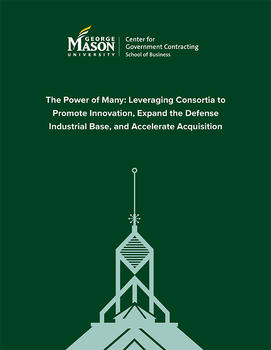In This Story
July 20, 2022 — The Center for Government Contracting releases a new report, “The Power of Many: Leveraging Consortia to Promote Innovation, Expand the Defense Industrial Base, and Accelerate Acquisition.”

Key findings: The Consortia Model promotes innovation,
expands the industrial base, and accelerates acquisition
Key findings from the report include: the consortia model enhances communication between government and industry via dedicated collaboration events; the consortia model expands the defense industrial base as nontraditional defense contractors make up 77% of the membership for the 12 consortia surveyed and serve as the lead contractor on nearly 70% of awards through those consortia; and in certain circumstances, the consortia model can significantly speed up acquisition timeliness and free up the DoD acquisition workforce to perform other critical tasks.
The report is co-authored by George Mason University Center for Government Contracting Senior Fellow Stephanie Halcrow and Moshe Schwartz, President of Etherton & Associates.
“The data paints a clear picture that the consortia model plays a vital and growing role in the defense innovation ecosystem,” said report co-author Stephanie Halcrow. “Most significantly, consortia create a space for government–industry collaboration and bring the value of nontraditional contractors and small businesses to the table. Going forward, we see the role of consortia only increasing as the need for innovation and expanding the industrial base continues to be critical for the security of the nation and our warfighters.”
Building on previous research into Other Transaction Agreements (OTAs), the report includes the participation of twelve distinct DoD consortia which provided data and case studies to researchers. Based on the research, interviews, and data analysis, the authors found the consortia model supports government acquisition efforts by:
- Promoting government-industry-academia communication,
- Facilitating industry partnerships and collaboration,
- Providing critical surge capacity to government acquisition,
- Offering a ready, pre-established network of potential suppliers who have expertise in specific areas,
- Helping government program offices that do not have the requisite skill and experience in executing OTs, and
- Supporting the expansion of the defense innovation base by bringing nontraditional defense contractors and small businesses into that base.
Additionally, the report emphasizes support for transparency and oversight in order to safeguard the interests of taxpayers and government but cautions against onerous legislation and regulations that have the potential to undermine the consortia model and OTs.
To strike the right balance, the authors provide seven specific recommendations to improve the consortia model going forward: improve visibility and transparency; enhance training and develop best practices; focus on transitioning technology to production; avoid additional regulatory burdens; preserve the definition of Nontraditional Defense Contractor; promote collaboration and innovation through flexibility; and expand the use of Other Transaction Authorities.
“This important research shines a bright light on a critical source of innovation in the government contracting community and we look forward to the continued growth of ‘the power of many’ in the future,” noted Center Executive Director Jerry McGinn.
“The consortia model is an important tool in the acquisition toolbox that provides meaningful benefits to both government and industry,” said report co-author Moshe Schwartz, “It is important that the government acquisition workforce understand when and how to use and manage consortia effectively. This report indicates that when done right, consortia expand the industrial base, promote collaboration, and more efficiently deliver the innovative technologies our armed forces require to maintain their edge.”
